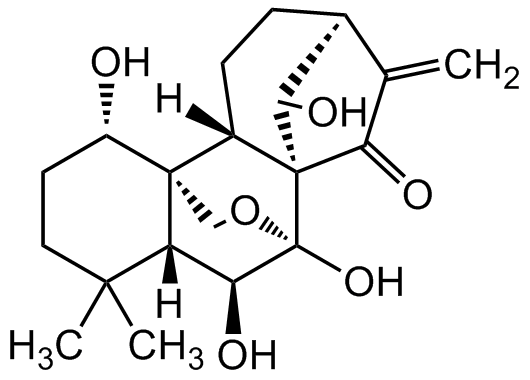Oridonin
| Code | Size | Price |
|---|
| CDX-O0131-M005 | 5 mg | £53.00 |
Quantity:
| CDX-O0131-M025 | 25 mg | £157.00 |
Quantity:
Prices exclude any Taxes / VAT
Overview
Host Type: Plant
Regulatory Status: RUO
Shipping:
AMBIENT
Storage:
Short Term: +20°C, Long Term: +4°C
Images
Further Information
Alternate Names/Synonyms:
7alpha,20-Epoxy-1alpha,6beta,7,14-tetrahydroxy-Kaur-16-en-15-one, NSC 250682
Appearance:
White to off-white powder.
CAS:
28957-04-2
EClass:
32160000
Form (Short):
liquid
Handling Advice:
Protect from light and moisture.
InChi:
InChI=1S/C20H28O6/c1-9-10-4-5-11-18-8-26-20(25,19(11,14(9)22)15(10)23)16(24)13(18)17(2,3)7-6-12(18)21/h10-13,15-16,21,23-25H,1,4-8H2,2-3H3/t10-,11-,12-,13+,15+,16-,18+,19-,20+/m0/s1
InChiKey:
SDHTXBWLVGWJFT-XKCURVIJSA-N
Long Description:
Chemical. CAS: 28957-04-2. Formula: C20H28O6. MW: 364.43. Oridonin is a diterpenoid that has been found in R. rubescens and has anti-inflammatory and anticancer, antimicrobial and neuroprotective properties. The regulatory anticancer mechanisms include induction of apoptosis and autophagy, inhibition of proliferation, inhibition of angiogenesis, cell cycle arrest. It is an inhibitor of the TLR4/p38-MAPK and TLR4/NF-kappa signaling pathways and PPARgamma. Oridonin is a high affinity inhibitor of NLRP3 inflammasome assembly and activation (Kd = 52.5 nM). It inhibits inflammation in wild-type, but not Nlrp3-/-, mice in a model of high-fat diet-induced type 2 diabetes. Also inhibits glial activation, decreases inflammatory cytokine release, attenuates synaptic loss and improves behavioural deficits in Abeta1-42 treated mice.
MDL:
MFCD00221762
Molecular Formula:
C20H28O6
Molecular Weight:
364.43
Package Type:
Vial
Product Description:
Oridonin is a diterpenoid that has been found in R. rubescens and has anti-inflammatory and anticancer, antimicrobial and neuroprotective properties. The regulatory anticancer mechanisms include induction of apoptosis and autophagy, inhibition of proliferation, inhibition of angiogenesis, cell cycle arrest. It is an inhibitor of the TLR4/p38-MAPK and TLR4/NF-kappa signaling pathways and PPARgamma. Oridonin is a high affinity inhibitor of NLRP3 inflammasome assembly and activation (Kd = 52.5 nM). It inhibits inflammation in wild-type, but not Nlrp3-/-, mice in a model of high-fat diet-induced type 2 diabetes. Also inhibits glial activation, decreases inflammatory cytokine release, attenuates synaptic loss and improves behavioural deficits in Abeta1-42 treated mice. CRL/SCF RING E3 inhibitor. Inhibits Fbw7 an E3 ubiquitin ligase (CRL/SCF RING) of c-Myc and promotes proteasomal degradation.
Purity:
>98% (HPLC)
SMILES:
O[C@@H]1[C@]2(CO3)[C@@]([C@H](O)[C@]3(O)[C@@](C4=O)([C@@H]5O)[C@@]2([H])CC[C@H]5C4=C)([H])C(C)(C)CC1
Solubility Chemicals:
Soluble in DMSO (20mg/ml), DMF (20mg/ml) or ethanol (20mg/ml). Insoluble in water.
Source / Host:
Plant
Transportation:
Non-hazardous
UNSPSC Category:
Natural Products/Extracts
UNSPSC Number:
12352200
Use & Stability:
Stable for at least 2 years after receipt when stored at +4°C.
References
(1) T. Ikezoe, et al.; Int. J. Oncol. 23, 1187 (2003) | (2) J.J. Liu, et al.; Ann. Hematol. 83, 691 (2004) | (3) T. Ikezoe, et al.; Mol. Cancer Ther. 4, 578 (2005) | (4) Q. Cui, et al.; J. Pharmacol. Sci. 105, 317 (2007) | (5) H. Wang, et al.; Oncol. Rep. 24, 647 (2010) | (6) H.L. Huang, et al.; Mol. Cancer Ther. 11, 1155 (2012) | (7) Z. Liu, et al.; Cell Prolif. 45, 499 (2012) (Review) | (8) S. Wang, et al.; PLoS One 9, e104745 (2014) | (9) B.A. Owona & H.J. Schluesener; Drugs R.D. 15, 233 (2015) (Review) | (10) S. Wang, et al; PLoS One 11, e0151397 (2016) | (11) L. Tian, et al.; BMC Complement. Altern. Med. 17, 192 (2017) | (12) J. Li, et al.; Int. Immunopharmacol. 55, 9 (2018) | (13) J. Xu, et al.; Molecules 23, E474 (2018) (Review) | (14) H. He, et al.; Nat. Commun. 9, 2550 (2018) | (15) T. Jia, et al.; Int. Immunopharmacol. 69, 382 (2019)



